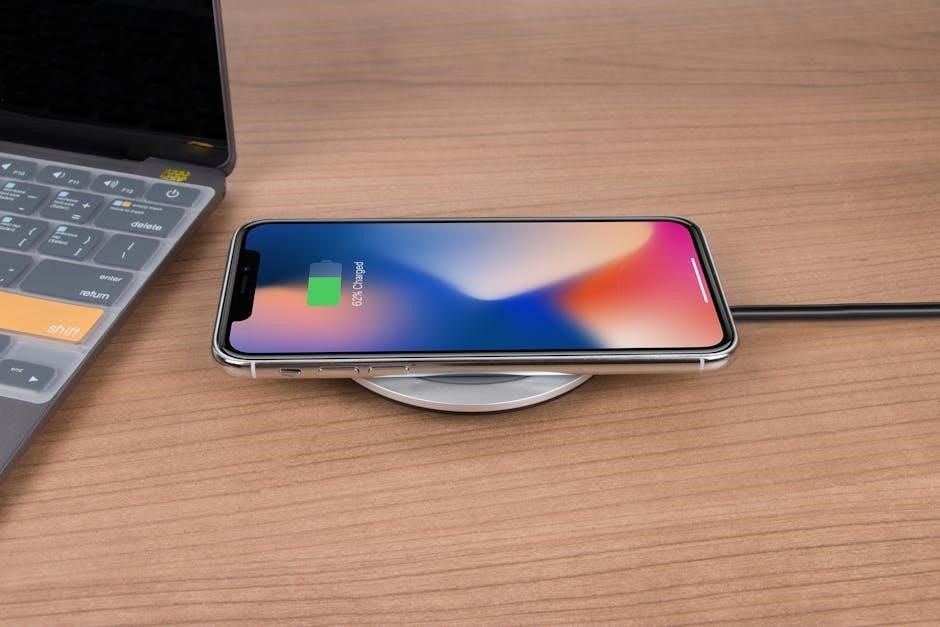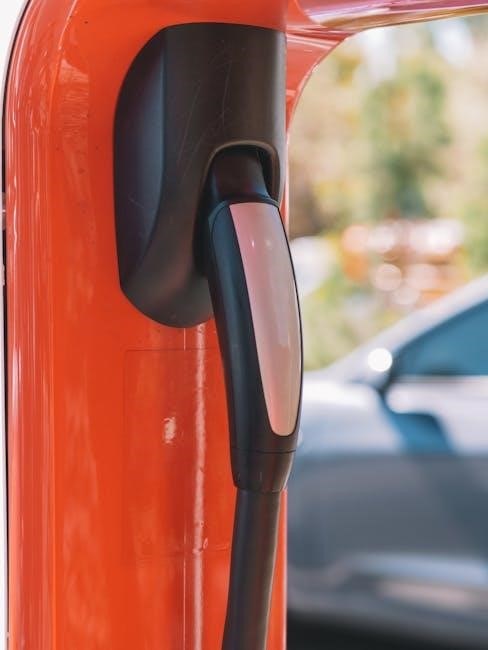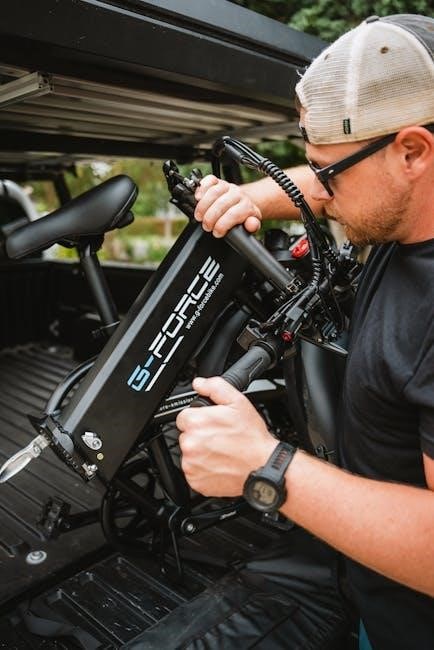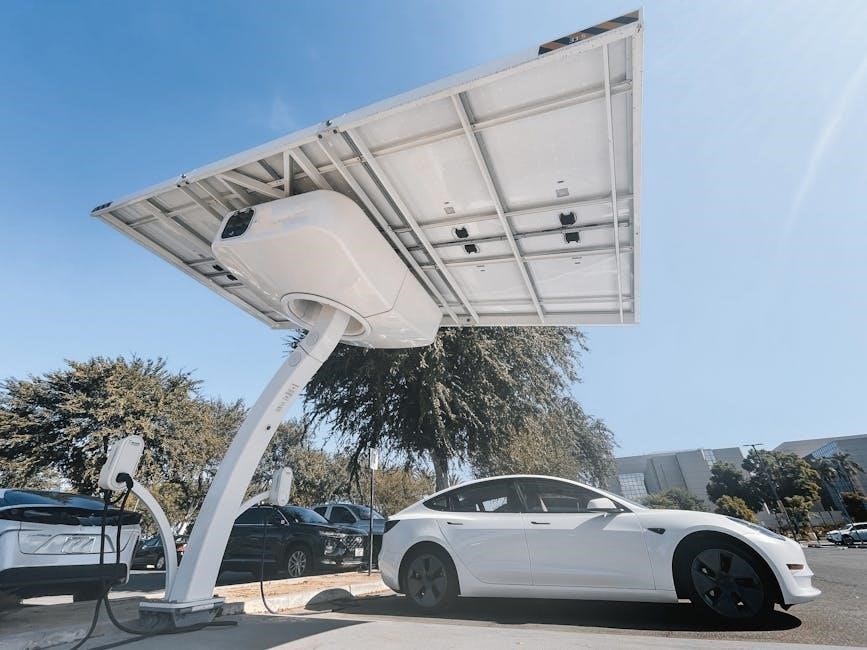Schumacher battery chargers are trusted for their reliability and performance, offering advanced charging solutions for various battery types. Popular among professionals and DIYers, they provide efficient, safe, and user-friendly charging experiences.
1.1 Overview of Schumacher Battery Chargers
Schumacher battery chargers are renowned for their durability and versatility, catering to a wide range of battery types, including lead-acid, AGM, and gel batteries. They feature advanced smart technology, user-friendly interfaces, and robust safety mechanisms. Models like the SC1280 and SC1445 are popular for their efficient charging capabilities and compact designs. These chargers often include digital displays, multiple charging modes, and automatic maintenance features, ensuring optimal performance and longevity for vehicle and marine batteries alike.
1.2 Importance of Understanding Charger Features
Understanding Schumacher battery charger features is crucial for safe and effective battery maintenance. Features like digital displays, charge rate selection, and automatic shut-off ensure optimal charging. Misusing these can lead to battery damage or safety hazards. Familiarizing yourself with the control panel, error codes, and charging modes helps troubleshoot issues and extend battery life. Proper usage prevents corrosion, overheating, and mechanical faults, ensuring reliable performance for vehicles and equipment. Knowledge of these features enhances user confidence and operational efficiency.

Safety Precautions When Using Schumacher Chargers
Avoid placing batteries on the charger to prevent corrosion. Ensure proper ventilation and keep the charger away from flammable materials. Never operate in closed areas.
2.1 General Safety Guidelines
Always follow safety guidelines when using Schumacher chargers to prevent accidents. Ensure the charger is placed on a stable, heat-resistant surface and avoid exposing it to water. Prevent battery acid from dripping onto the charger when handling batteries. Keep the area well-ventilated and avoid operating the charger in enclosed spaces. Never touch electrical components with wet hands or while standing in water. Read the manual thoroughly and adhere to all instructions for safe operation.
2.2 Preventing Corrosion and Damage
Regularly clean the charger and clamps to prevent corrosion from battery acid or moisture. Avoid setting the battery on top of the charger, as acid drips can damage the unit. Store the charger in a dry, cool place when not in use. Ensure proper ventilation during charging to prevent hydrogen gas buildup. After use, unplug the charger and allow it to cool down before storing. This helps extend the lifespan and maintain performance.
2.3 Proper Ventilation and Charger Placement
Ensure the charger is placed in a well-ventilated area to prevent hydrogen gas buildup, which can be explosive. Never operate the charger in a closed-in space or restrict airflow. Keep the charger away from flammable materials and ensure it is on a stable, heat-resistant surface. Proper ventilation and placement protect both the charger and surrounding environment from potential hazards, ensuring safe and efficient charging.

Understanding the Charger’s Control Panel
The control panel features a digital display showing charge percentage, voltage, and cooldown time. It includes buttons for mode selection and rate adjustment, ensuring user-friendly operation and monitoring.
3.1 Location and Function of Key Components
The control panel houses essential components like the digital display, mode selection buttons, and the reset button. The digital display shows charge percentage, voltage, and cooldown time, while buttons allow mode and rate adjustments. The reset button, often located near the control panel, is used to reset the charger, addressing issues like error codes or display malfunctions. These components are strategically placed for easy access, ensuring efficient operation and troubleshooting.
3.2 Digital Display and Its Indications
The digital display provides real-time feedback, showing the battery’s charge percentage and voltage at the clamps. It also indicates the remaining cooldown time in seconds after Engine Start mode. This display helps users monitor charging progress and ensures safe operation by alerting them to potential issues. The clear interface simplifies troubleshooting and maintains user awareness of the charger’s status and battery condition throughout the charging process.

Locating the Reset Button on Schumacher Chargers
The reset button is typically located on the control panel, often near the digital display or mode switches. Its position may vary slightly by model.
4.1 Identifying the Reset Button
The reset button on Schumacher chargers is typically small and recessed, located on the control panel. It may be labeled as “Reset” or marked with a symbol. Check near the digital display or mode switches, as its position varies by model; Refer to your manual for exact location, as some models hide it to prevent accidental presses. Ensure the charger is unplugged before attempting to reset to avoid any potential risks or electrical issues.
4.2 Variations Across Different Models
The location of the reset button varies across Schumacher charger models. For instance, the SC1280 model features the reset button on the front panel, near the digital display, while the SC1445 model places it on the side or rear. Some models, like the SC1632, hide the reset button under a protective cover to prevent accidental activation. Always consult the specific model’s manual for precise location details, as designs differ slightly between chargers. This ensures safe and effective reset operations.
Step-by-Step Guide to Resetting the Charger
Unplug the charger, locate the reset button (position varies by model), press and hold it for 5 seconds, then plug it back in to reset.
5.1 Pre-Reset Checks
Before resetting your Schumacher charger, ensure it is unplugged from the power source to avoid electrical hazards. Verify the charger is in a well-ventilated area and free from obstructions. Check all connections, including clamps and cables, for damage or corrosion. Review the digital display for any error codes that may indicate specific issues. Consult the user manual for model-specific instructions, as some chargers may require additional steps before a reset can be performed safely and effectively.
5.2 Execution of the Reset Process
Locate the small, recessed reset button on the control panel, typically marked with an ‘R’ or ‘RESET.’ Using a paperclip or similar tool, press and hold the button for 10-15 seconds until the digital display resets. Ensure the charger is unplugged from the power source before resetting to avoid any electrical issues. Once reset, the charger will revert to default settings, allowing you to reconfigure it as needed. Always refer to the user manual for model-specific reset procedures to ensure proper execution.
Common Issues and Troubleshooting
Common issues include the charger not turning on, low charging output, or error codes. Troubleshooting involves checking connections, ensuring proper ventilation, and consulting the user manual for solutions.
6.1 Charger Not Turning On
If your Schumacher battery charger fails to turn on, check the power source and ensure it is properly plugged into a functioning outlet. Verify that the circuit breaker or fuse has not tripped. Inspect the power cord for damage or frays. Ensure all connections between the charger and battery are secure and free of corrosion. If issues persist, consult the user manual or contact customer support for further assistance or potential repair options.
6.2 Low Charging Output
Low charging output may indicate a faulty transformer, corroded clamps, or incorrect charge rate selection. Check connections for cleanliness and tightness. Ensure the charger is set to the correct battery type and charge rate. If using an extension cord, verify it is rated for the charger’s current.Inspect the transformer for damage or overheating. If issues persist, refer to the troubleshooting guide or contact Schumacher support for assistance, as internal components may require professional servicing to restore optimal performance.
6.3 Error Codes and Their Solutions
Error codes like “E1” or “E2” often indicate issues such as faulty clamps, incorrect battery type settings, or short circuits. Check connections for cleanliness and proper securement. Ensure the charger is set to the correct battery type and charge rate. If “E3” appears, it may signal a short circuit or overloaded output. Unplug the charger, inspect cables for damage, and restart. Refer to the user manual for specific code meanings and detailed troubleshooting steps to resolve the issue effectively.
Maintenance Tips for Prolonged Charger Life
- Clean clamps regularly to prevent corrosion and ensure proper connectivity.
- Store the charger in a dry, cool place, away from direct sunlight.
- Organize cords neatly to avoid damage and tangling.
7.1 Cleaning the Charger and Clamps
Regular cleaning is essential for maintaining your Schumacher battery charger’s performance. Use a soft, dry cloth to wipe down the charger’s exterior and clamps, removing dirt and residue. For tougher stains, dampen the cloth slightly but avoid harsh chemicals. After cleaning, ensure all surfaces are dry before storing or using the charger. This prevents corrosion and ensures reliable electrical connections. Regular maintenance helps extend the charger’s lifespan and ensures optimal charging efficiency over time.
7.2 Storing the Charger Properly
To maintain your Schumacher battery charger’s performance, store it in a cool, dry place away from direct sunlight and moisture. Keep it away from flammable materials and ensure it is not exposed to extreme temperatures. Disconnect the battery and any cables, coiling them neatly to prevent tangles. Clean the charger with a soft cloth before storage to avoid dirt buildup. Place it on a stable shelf or in a protective case to safeguard against damage. Regularly check the charger during extended storage to ensure it remains in good condition.
Popular Schumacher Charger Models
Schumacher offers several well-known models, including the SC1280, SC1445, and the 6000A, each recognized for their efficiency, durability, and user-friendly designs, catering to diverse charging needs.
8.1 SC1280 and SC1445 Models
The SC1280 and SC1445 are two of Schumacher’s most popular models, known for their efficiency and versatility. The SC1280 delivers 13 volts and 15 amperes, charging a 105Ah battery in 16 hours, while the SC1445 offers similar reliability. Both models are compact, lightweight, and feature ergonomic designs for easy transport. The reset button on these models is typically located on the control panel, ensuring easy access for troubleshooting. These chargers are ideal for both small and large batteries, making them a favorite among users who value performance and convenience.
8.2 Features and Capabilities
Schumacher chargers like the SC1280 and SC1445 boast advanced features, including smart technology for optimized charging and user-friendly controls. They offer multiple charge rates and compatibility with various battery types, such as lead-acid, AGM, and gel batteries. The digital display provides real-time charge percentages and voltage levels, enhancing monitoring. Safety mechanisms prevent overcharging and overheating, ensuring a secure charging process. Their robust design and intelligent features make them suitable for both professional and home use, catering to a wide range of charging needs effectively.

Charging Considerations
Schumacher chargers offer versatile charging options, including in-vehicle use and Engine Start mode, with a 180-second cooldown after 3 minutes, ensuring safe, efficient operation.
9.1 Charging in Vehicles
When charging in vehicles, ensure the charger is placed in a well-ventilated area to prevent explosive gas buildup. Avoid closed-in spaces and restrict ventilation. After 3 minutes in Engine Start mode, the charger enters a 180-second cooldown period, allowing the charger and battery to cool down. Always follow DC connection precautions and avoid battery acid drips. Proper placement and ventilation are critical for safe and efficient charging in vehicles.
9.2 Using the Engine Start Mode
The Engine Start mode on Schumacher chargers allows for quick engine starting when the battery is deeply discharged. After 3 minutes of use, the charger enters a 180-second cooldown period, during which the digital display shows the remaining time. This feature ensures the charger and battery cool down properly, preventing overheating. Always wait a few minutes before cranking the engine again to allow cooling, ensuring safe and effective use of the Engine Start mode.
This guide provides a comprehensive overview of Schumacher battery chargers, emphasizing safety, features, and maintenance. Understanding these aspects ensures optimal performance and longevity of your charger and battery.
10.1 Summary of Key Points
This guide provides a comprehensive overview of Schumacher battery chargers, focusing on safety, functionality, and maintenance. Key points include locating the reset button, troubleshooting common issues, and understanding charger features. Proper ventilation, preventing corrosion, and adhering to safety guidelines are emphasized. Popular models like the SC1280 and SC1445 are highlighted for their efficiency and reliability. Regular maintenance, such as cleaning clamps and storing the charger correctly, ensures prolonged performance. Always follow safety precautions to maximize charging efficiency and battery life.